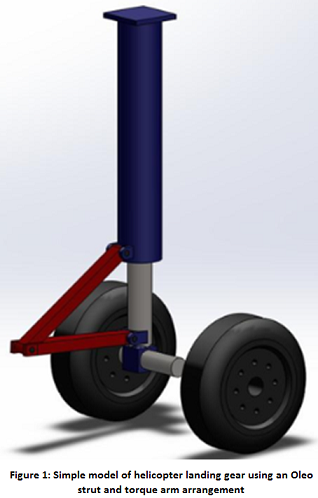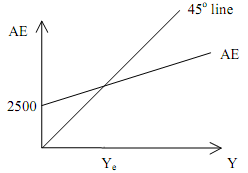Reference no: EM131026103
Midterm 2-
Part I: Matching:
|
1. Investment
|
A. The sum of the incomes that all individuals in the economy earned in the forms of wages, interest, rents, and profits, for any given year.
|
|
2. U.S. Net Exports
|
B. The total amount that all consumers, business firms, and government agencies are willing to spend on final goods and services, for any given year.
|
|
3. Gross National Income
|
C. The difference between U.S. exports and U.S. imports in any given year.
|
|
4. Aggregate demand
|
D. The relationship between total consumer expenditure and total disposable income in the economy, holding all other determinants of consumer spending constant, for any given year.
|
|
5. The "Simple" Multiplier
|
E. The sum of the incomes of all the individuals in the economy after all taxes have been deducted and all transfer payments have been added, for any given year.
|
|
|
F. It is the sum of the expenditures by firms on new plant and equipment and by households on new homes, in any given year.
|
|
G. 1/(1-MPC)
|
|
H. The ratio of the change in consumption to the change in disposable income that produces the change in consumption.
|

Use the graph above to match the following items:
|
1. The distance that represents the dissavings at income level OA.
|
A. OA
|
|
2. The distance that represents autonomous consumption.
|
B. OB
|
|
3.The Marginal Propensity to Consume
|
C. OC
|
|
4. At this income level, there is no savings.
|
D. FG
|
|
5. The Marginal Propensity to Save
|
E. OE
|
|
6. The distance that represents consumption at income level OA.
|
F. AF
|
|
G. AG
|
|
H. EL
|
|
I. IJ/HK
|
|
J. IK/HK
|
|
K. JK/HK
|
|
L. HK/IJ
|
|
M. HK/IK
|
Part II: Short Answers:
1. Fill in the blanks on the table, and answer the following questions:
Table
|
Row
#
|
Y (Income)
|
T (Tax)
|
Yd(Disposable Income)
|
C (Consumption)
|
S (Saving)
|
|
1
|
120
|
20
|
|
150
|
|
|
2
|
|
20
|
|
|
-30
|
|
3
|
|
20
|
300
|
|
|
|
4
|
|
20
|
|
390
|
10
|
What is the MPC?
What is the MPS?
What is the autonomous Consumption level (with respect to Yd)?
The equilibrium level of Y is between ... (circle one)
Rows 1 and 2
Rows 2 and 3
Rows 3 and 4
2. Use the following economic model to answer the questions a)-g).
C=150+.75(Y-T)
T = 200
G=200
I=50
X = 200
M=40
a. Find the equilibrium output in this economy.
b. What is the savings equation (in terms of disposable income)?
c. Find equilibrium savings.
d. Show that in equilibrium, leakages equal injections (be sure to list all leakages and injections).
e. Suppose that investment spending increased by 50, to 150. What will be the CHANGE in equilibrium output?
f. Suppose this economy is initially at the equilibrium found in part (a). (Ignore part (e)). Further suppose that the full-employment GDP (YFE) equals 2000. How much would government expenditures have to change to achieve full-employment?
g. Suppose that the government must have a balanced budget, i.e., G = T. Now, to reach YFE = 2000, what must the change in G and the change in T be equal to?
Change in G = _______, and the change in T = ______.
3. Consider the following Keynesian model:
C = 40 + 0.8(Y-T),
T = 50 + .5Y,
I = 20,
G = 40
a. Which sector is ignored in the above model?
b. What is the equation for Aggregate Expenditures?
c. Find equilibrium output in this economy.
d. If the Full Employment level of GDP is equal to 500, how will employment change if we increase G?
What type of unemployment will be directly affected by this change in G?
Answer one of the two following questions for 1 point (total):
- What country was Keynes from?
- Where did Keynes like to work?
Part III: Multiple Choice Questions:
1. Suppose that the income tax rate is 0.25, and the MPS (Marginal Propensity to Save) with respect to disposable income is 0.2. What is the tax expenditure multiplier for a change in autonomous taxes? Assume that the income tax rate remains constant.
a) -.25
b) -1.25
c) -2
d) -4
e) -5
2. In a Keynesian model, if Y > AE, which of the following statements are true?
I. Inventories will fall.
II. Inventories will rise.
III. Prices will fall.
IV. Prices will rise.
a) I only.
b) II only.
c) I and III.
d) I and IV.
e) II and III.
3. Suppose Bill borrows $2000 from Jane for one year; at the end of that time period, he will pay her $2500. Which of the following is true?
a) The real interest rate is always 25%.
b) The nominal interest rate is NOT always 25%.
c) If Bill anticipates inflation will be 20%, then he expects to pay 45% nominal interest.
d) Jane will earn more profit if the inflation rate is higher than expected.
e) If Jane thinks inflation will be 10%, then she expects to receive 15% real interest.
Use the following information to answer the next two questions.
The small town of Macroland has a population of 1,200. The population of juveniles (under age 16) is 200. Labor force participation rate of this town is 80%. Unemployment rates are as follows: Frictional = 2%, Structural = 2%, Cyclical = 4%.
4. What is the size of the labor force in Macroland ?
a) 800
b) 960
c) 1,000
d) 1,200
e) 1,300
5. Suppose that Macroland reaches full employment. How many persons are unemployed?
a) 0
b) 16
c) 20
d) 32
e) 40
6. Suppose real GDP for 1997 in terms of 1996 prices is $2000. The GDP deflator for 1997 is 120 and the GDP deflator for 1996 is 100, but the CPI for 1997 is 150. What is the nominal GDP for 1997?
a) Nominal GDP for 1997 is $1666.
b) Nominal GDP for 1997 is $2000.
c) Nominal GDP for 1997 is $2400.
d) Nominal GDP for 1997 is $3000.
e) We need more information to answer this question.
Use the following information and the accompanying graph to answer the next two questions:
C = 1500 + .9Yd
I = I0
G = 500
T = 500

7. Using the above graph, what is the autonomous investment level (I0)?
a) 500
b) 950
c) 1050
d) 1500
f) 2500
8. Congress decides to pass an income tax, t>0, so that the new tax revenue equation becomes: T = 500 + t*Y. Which of the following statements is TRUE:
I. The Aggregate Expenditure function gets steeper.
II. The Aggregate Expenditure function gets flatter.
III. Equilibrium Output will fall.
IV. Equilibrium Output will rise.
a. I and III.
b. I and IV.
c. II and III.
d. II and IV.
e. II only.
9. Which of the following is always TRUE (assuming that taxes and government expenditures are given and constant throughout this problem)?
a) At any income level, leakages always equal injections.
b) If there is inflation between period 1 and 2, nominal GDP growth rate between those periods is less than real GDP growth rate.
c) Coca-Cola made and sold in Japan is included in United States GDP.
d) At the equilibrium level of income (GDP), a decrease in net exports causes saving to increase.
e) None of the above.
10. The Marginal Propensity to Consume tells us...
a) How much of a given income will be consumed.
b) What percentage of total income will go to saving.
c) How much consumption will occur at equilibrium.
d) How much of a change in disposable income will be consumed.
e) How much consumers spend as a function of their disposable income.